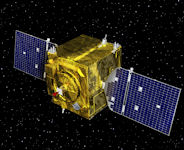Geosynchronous Space Situational Awareness Program (GSSAP)
GSSAP satellites are a space-based capability operating in the near-geosynchronous orbit regime supporting U.S. Strategic Command space surveillance operations as a dedicated Space Surveillance Network (SSN) sensor. GSSAP satellites support Joint Functional Component Command for Space (JFCC SPACE) tasking to collect space situational awareness data allowing for more accurate tracking and characterization of man made orbiting objects. From a near-geosynchronous orbit, it will have a clear, unobstructed and distinct vantage point for viewing Resident Space Objects (RSOs) without the interruption of weather or the atmospheric distortion that can limit ground-based systems.
GSSAP satellites operate near the geosynchronous belt and will have the capability to perform Rendezvous and Proximity Operations (RPO). RPO allows for the space vehicle to maneuver near a resident space object of interest, enabling characterization for anomaly resolution and enhanced surveillance, while maintaining flight safety. Data from GSSAP will uniquely contribute to timely and accurate orbital predictions, enhancing our knowledge of the geosynchronous orbit environment, and further enabling space flight safety to include satellite collision avoidance.
GSSAP satellites communicate information through the world-wide Air Force Satellite Control Network (AFSCN) ground stations, then to Schriever Air Force Base, CO where 50th Space Wing satellite operators of the 1st Space Operations Squadron (1 SOPS) oversee day-to-day operations.
The Geosynchronous Space Situational Awareness Program (GSSAP) is part of the US’s future Space Based Space Surveillance (SBSS) system that will be formed by a whole constellation of satellites to enable the US to track down space objects in various orbits around the planet. GSSAP was aimed at possible space conflicts, when some nation might try to shoot down or disable American military satellites that form the backbone of US intelligence, missile targeting and communication capabilities.
The first two Geosynchronous Space Situational Awareness Program (GSSAP) satellites were successfully launched aboard a United Launch Alliance (ULA) Delta IV M+ (4,2) booster configuration from Cape Canaveral AFS, FL on July 28, 2014. The backup set of two satellites would be delivered to orbit in 2016.
The 63-meter-tall Delta IV rocket (Medium+ configuration, two solid fuel rocket boosters), built by the Lockheed Martin/Boeing joint venture United Launch Alliance, with two GSSAP satellites and a small ANGELS program experimental satellite, blasted off at 7:28 PM EDT from Patrick Air Force Base at Cape Canaveral, Florida. Originally, the launch was due to take place July 23. But after a technical issue with ground support equipment, and then three delays due to poor weather conditions, the booster blast off took place from Launch Complex 37.
“This neighborhood watch twosome will help protect our previous assets in geo, plus they will be on the lookout for nefarious capability other nations may try to place in that critical orbital regime,” the head of US Air Force Space Command, General William Shelton, told reporters. “We will learn a great deal about the geo traffic with the images produced from these two satellites.” Both satellites could easily change their orbit position so that operators on the ground could have “the best possible vantage point for collecting images when required,” Shelton said, “to improve space situational awareness.” “A picture is worth a thousand inferences because we can see literally what that [foreign] satellite looks like, and you can effectively reverse-engineer and understand what the capabilities are... to a much greater extent than you can today,” Shelton said.
“There are myriad counter-space threats that we are seeing on the near horizon,” he said, promising to “adjust our spacecraft constellations to survive in a very different environment from what we've had in the past.” The GSSAP satellites “could certainly be considered offensive,” Defense News reported Marco Caceres, an analyst with the Teal Group, as saying. “Obviously, the US Air Force is primarily thinking of it as defensive or simply from a maintenance and repair standpoint. But if you have the ability to get close enough to other satellites to observe or repair or refuel, then sure, you could probably take them out.” But Defense News reported Shelton as saying: “We do have an inherent right to safely maneuver around and monitor potentially threatening satellites.”
Neither the costs, nor technical details of the GSSAP program had so far been released. The GSSAP constellation would consist of four satellites, launched in pairs from Cape Canaveral, FL. Once cmplete, the constellation will revolutionize space-based space surveillance operations. It will provide the capability to perform persistent monitoring and neighborhood watch capability in geosynchronous Earth orbit (GEO).
The previously classified program will help the Air Force track man-made orbiting objects in high-altitude orbits, a region populated by the military's strategic communications and early warning satellites. The capabilities of existing space surveillance assets on the ground and in orbit a few hundred miles above Earth are limited in detecting satellite movements at higher altitudes.
GSSAP satellites will support Joint Functional Component Command for Space (JFCC SPACE) tasking to collect space situational awareness data allowing for more accurate tracking and characterization of man made orbiting objects. From a near-geosynchronous orbit, it will have a clear, unobstructed and distinct vantage point for viewing Resident Space Objects (RSOs) without the interruption of weather or the atmospheric distortion that can limit ground-based systems.
Two GSSAP satellites launched aboard a United Launch Alliance (ULA) Delta IV M+ (4,2) booster configuration from Cape Canaveral AFS, FL on July 28, 2014. The next Delta 4 launch will put the second pair of Geosynchronous Space Situational Awareness Program, or GSSAP, inspector satellites into geosynchronous orbit for US Strategic Command from the Cape in August 2016.
|
NEWSLETTER
|
| Join the GlobalSecurity.org mailing list |
|
|
|



